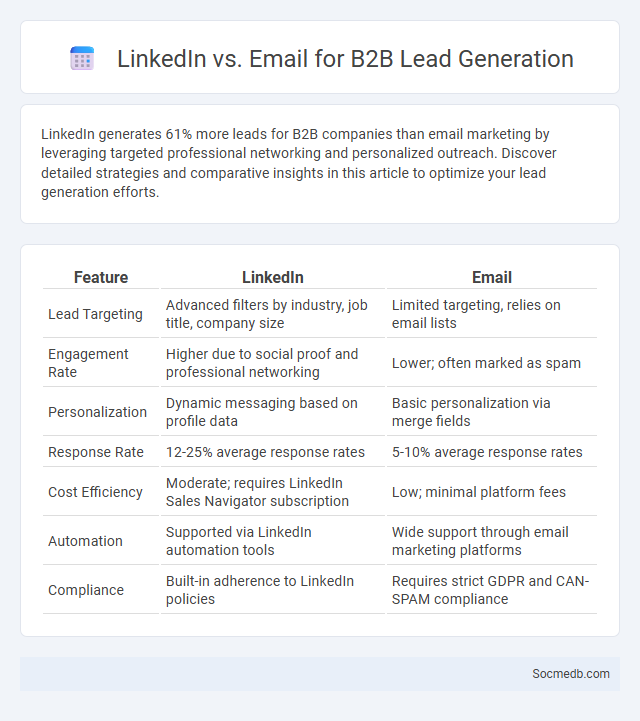
Photo illustration: LinkedIn vs Email for B2B Lead Generation
LinkedIn generates 61% more leads for B2B companies than email marketing by leveraging targeted professional networking and personalized outreach. Discover detailed strategies and comparative insights in this article to optimize your lead generation efforts.
Table of Comparison
| Feature | ||
|---|---|---|
| Lead Targeting | Advanced filters by industry, job title, company size | Limited targeting, relies on email lists |
| Engagement Rate | Higher due to social proof and professional networking | Lower; often marked as spam |
| Personalization | Dynamic messaging based on profile data | Basic personalization via merge fields |
| Response Rate | 12-25% average response rates | 5-10% average response rates |
| Cost Efficiency | Moderate; requires LinkedIn Sales Navigator subscription | Low; minimal platform fees |
| Automation | Supported via LinkedIn automation tools | Wide support through email marketing platforms |
| Compliance | Built-in adherence to LinkedIn policies | Requires strict GDPR and CAN-SPAM compliance |
Understanding B2B Lead Generation
B2B lead generation on social media leverages platforms like LinkedIn, Twitter, and Facebook to identify and engage potential business clients through targeted content and personalized messaging. Utilizing advanced analytics and AI-driven tools enhances audience segmentation, allowing marketers to deliver relevant value propositions that drive higher conversion rates. Consistent engagement through educational posts, case studies, and webinars establishes credibility and nurtures trust in the buyer's journey.
Key Differences: LinkedIn vs Email
LinkedIn offers a dynamic platform for professional networking with real-time interactions, endorsements, and a public profile showcasing your career achievements, while email provides a private, direct communication channel suited for formal, detailed correspondence. Your LinkedIn messages can quickly tap into a broader network through connections and recommendations, whereas email ensures a more controlled and secure conversation, often preferred for confidential or official exchanges. Understanding these differences helps you choose LinkedIn for expanding professional visibility and email for personalized, in-depth communication.
Pros and Cons of LinkedIn Lead Generation
LinkedIn lead generation offers targeted access to professionals, enabling precise B2B marketing and higher-quality leads due to its business-focused user base. However, competition is intense, and success requires consistent engagement and well-crafted content to build trust and relationships effectively. By leveraging LinkedIn strategically, you can enhance your networking opportunities and generate valuable sales prospects while balancing the time and effort investment needed.
Pros and Cons of Email Lead Generation
Email lead generation offers highly targeted marketing opportunities by directly reaching potential customers' inboxes, enabling personalized content that boosts engagement and conversion rates. The method provides cost-effective scalability and measurable analytics to optimize campaigns and improve ROI over time. However, challenges include the risk of low open rates due to spam filters, potential subscriber fatigue causing high unsubscribe rates, and strict compliance requirements with laws like GDPR and CAN-SPAM affecting list management and campaign execution.
Audience Targeting: LinkedIn vs Email
LinkedIn offers precise audience targeting through professional criteria such as job title, industry, company size, and seniority level, enabling marketers to reach decision-makers and niche B2B segments effectively. Email marketing allows segmentation based on past interactions, purchase history, and demographic data, providing personalized content that drives higher engagement and conversion rates. Both platforms leverage data-driven strategies, but LinkedIn excels in professional context targeting while email ensures direct, customizable communication with established contacts.
Conversion Rates Comparison
Conversion rates on social media platforms vary significantly, with Instagram and Facebook typically outperforming Twitter and LinkedIn due to their advanced advertising algorithms and richer visual content formats. Facebook boasts an average conversion rate of 9.21% for ecommerce, while Instagram follows closely at 8.63%, highlighting their effectiveness in driving purchase decisions. Twitter's lower engagement and LinkedIn's focus on B2B networking result in average conversion rates around 1-3%, making targeted content and precise audience segmentation essential for maximizing ROI on these platforms.
Cost-Effectiveness and ROI
Social media marketing delivers high cost-effectiveness by enabling targeted campaigns that reach specific audiences with minimal budget compared to traditional advertising channels. Platforms like Facebook, Instagram, and LinkedIn provide detailed analytics that help optimize ad spend and improve return on investment (ROI) through precise audience segmentation and performance tracking. Businesses leveraging social media often experience increased brand awareness, higher engagement rates, and measurable sales conversions, which collectively enhance overall marketing efficiency.
Best Practices for LinkedIn B2B Outreach
Effective LinkedIn B2B outreach requires personalized messaging that addresses specific pain points of target decision-makers and highlights clear value propositions. Consistent engagement through insightful posts, meaningful comments, and strategic connection requests enhances credibility and fosters authentic relationships. Leveraging LinkedIn's advanced filters and Sales Navigator can optimize lead targeting and improve conversion rates by focusing on relevant industries and company sizes.
Best Practices for Email B2B Campaigns
Effective B2B email campaigns leverage targeted segmentation, personalized content, and clear calls to action to maximize engagement and conversion rates. Incorporating A/B testing and analyzing open rates, click-through rates, and conversion metrics improves campaign performance over time. Ensuring compliance with GDPR and CAN-SPAM regulations maintains trust and protects brand reputation in professional communications.
Choosing the Right Channel for Your Business
Selecting the appropriate social media channel is critical for maximizing your business's online presence and engagement. Platforms like Instagram and TikTok are ideal for visually-driven brands targeting younger audiences, while LinkedIn suits B2B companies seeking professional networking opportunities. Understanding your target demographic and content style ensures your social media strategy aligns with customer preferences and business objectives.
 socmedb.com
socmedb.com